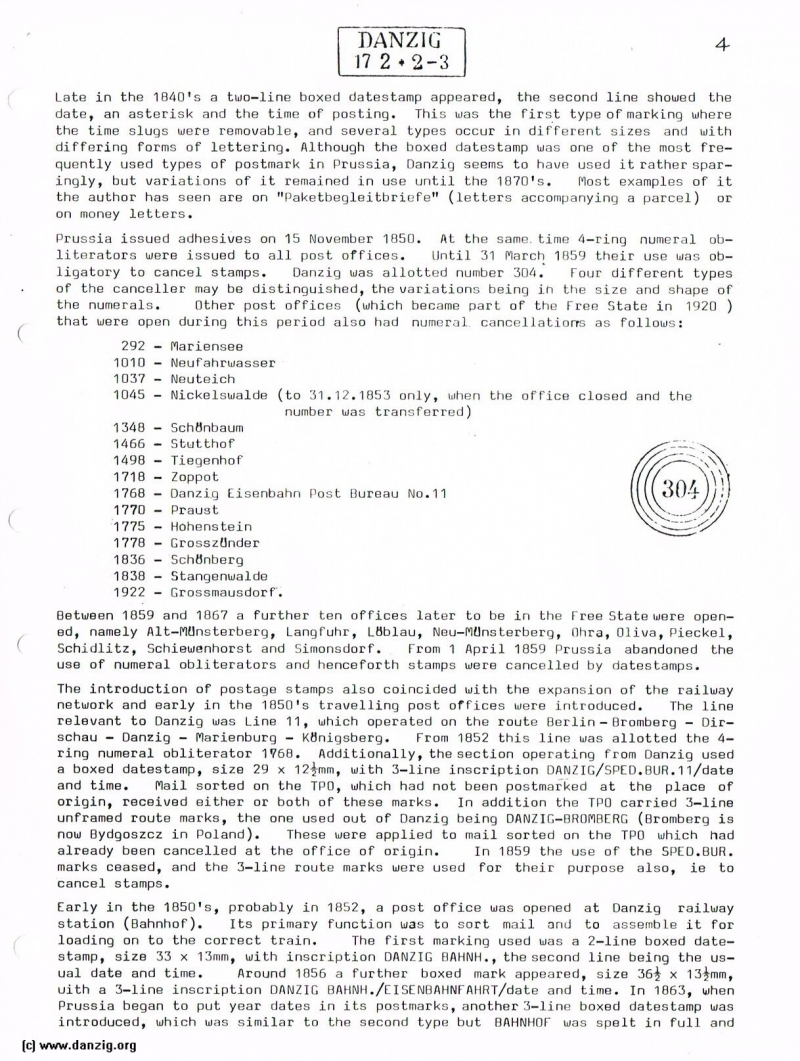
>> DANZIG: Postal History until 1920 - J. L. Whiteside
Late in the 1840’s a two line boxed datestamp appeared, the second line showed the date, an asterisk and the time of posting. This was the first type of marking where the time slugs were removable, and several types occur in different sizes and with differing forms of lettering. Although the boxed datestamp was one of’ the most frequently used types of postmark in Prussia, Danzig seems to have used it rather spar-. ingly, but variations of’ it remained in use until the 1070’s. Most examples of it the author has seen are on “Paketbegleitbricfe” (letters accompanying a parcel) or on money letters.
Prussia issued adhesives on 15 November 1850. At the same. time 4—ring numeral obliterators were issued to all post offices. Until 31 March 1859 their use was obligatory to cancel stamps. Danzig was allotted number 304. Four different types of the canceller may be distinguished, the variations being in the size and shape of the numerals. Other post offices (which became part of the Free State in 1920 ) that were open during this period also had numeral cancellators as follows:
292 — Mariensee
1010 — Neufahrwasser
1037 — Neuteich
1045 — Nickelswalde (to 31.12.1853 only, when the office closed and the number was transferred)
1348 — Schönbaum
1466 — Stutthof
1498 — Tiegenhof
1718 — Zoppot
1768 — Danzig Eisenbahn Post Bureau No.11
1770 — Proust
1775 — Hohenstein
1778 — Grossünder
1836 — Schönberg
1838 — Stangenwalde
1922 — Grossmausdorf.
Between 1859 and 1867 a further ten offices later to be in the Free State were open— md, namely Alt—Münsterberg, Langfuhr, Lüblau, Neu Münsterberg, Obra, Olive, Pieckel, Schidlitz, Schiewenhorst and Simonsdorf. From 1 April 1859 Prussia abandoned the use of numeral obliterators and henceforth stamps were cancelled by date stamps.
The introduction of postage stamps also coincided with the expansion of the railway network and early in the 1850’s travelling post offices were introduced. The line relevant to Danzig was Line 11, which operated on the route Berlin — Bromberg — Dirschau — Danzig — Marienburg — Königsberg. From 1852 this line was allotted the 4 — ring numeral obliterator 1’768. Additionally, the section operating from Danzig used a boxed datestamp, size 29 x 124mm, with 3—line inscription DANZIG/SPED. BUR. 11 / date and time. Mail sorted on the TPO, which had not been postmarked at the place of origin, received either or both of these marks. In addition the TPO carried 3—line unframed route marks, the one used out of’ Danzig being DANZIG — BROMBERG (Bromberg is now Bydgoszcz in Poland). These were applied to mail sorted on the TPO which had already been cancelled at the office of origin. In 1859 the use of the SPED. BUR. marks ceased, and the 3—line route marks were used for their purpose also, is to cancel stamps.
Early in the 1850’s, probably in 1852, a post office was opened at Danzig railway station (Bahnhof). Its primary function was to sort mail and to assemble it for loading on to the correct train. The first marking used was a 2—line boxed date— stamp, size 33 x 13mm, with inscription DANZIG BAHNH., the second line being the usual date and time. Around 1856 a further boxed mark appeared, size 364 x 134mm, with a 3—line inscription DANZIG BAHNH. / EISENBAHNFAHRT / date and time. In 1863, when Prussia began to put year dates in its postmarks, another 3—line boxed datestamp was introduced, which was similar to the second type but BAHNHOF was spelt in full and
Danzig Report Nr. 30 - January - February - March - 1981, Page 4.
Hits: 1926
Added: 11/06/2015
Copyright: 2024 Danzig.org

